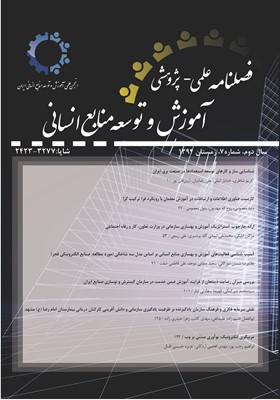مربی¬گری الکترونیک: نوآوری مبتنی بر وب
محورهای موضوعی :ابراهیم رجب پور 1 * , مهدی افخمی اردکانی 2 , عزیزه حسینی اقبال 3
1 - دانشگاه تهران
2 -
3 -
کلید واژه: مربی¬, گری مربی¬, گری الکترونیک پذیرش مربی¬, گری الکترونیک فناوری اطلاعات و ارتباطات نوآوری,
چکیده مقاله :
ظهور فناوری اطلاعات و ارتباطات و به خصوص اینترنت باعث ایجاد مفهوم جدید مربیگری الکترونیک در مدیریت منابع انسانی شده است. لذا با توجه به مزایای متعدد مربی گری الکترونیک برای سازمان ها؛ هدف از این پژوهش، ارائه مدل مربی گری الکترونیکی با استفاده از مطالعه تطبیقی و سنجش عوامل مؤثر بر پذیرش مربی گری الکترونیک در شرکت های ارائه دهنده خدمات فناوری اطلاعات می باشد. جامعه آماری اين پژوهش را مربیان شرکت های فعال در زمینه فناوری اطلاعات در سطح تهران تشكيل ميدهند و 258 نفر به عنوان نمونه آماري انتخاب شدند که از بین آنان 104 پرسشنامه به طور کامل پاسخ داده شد. براي انتخاب نمونه آماري از روش نمونهگيري تصادفي طبقه اي استفاده شد. تأیید روایی پرسشنامه از نظرات اعضای هیئت علمی و افراد صاحب نظر در این زمینه بررسی شد. پایایی پرسشنامه توسط آلفای کرونباخ سنجیده شد؛ این ضریب برای عوامل مختلف پرسشنامه بین 74/0 تا 91/0 بدست آمد. براي تحليل داده ها از روش هاي مدل سازی معدلات ساختاری، آمار توصيفي و آمار استنباطي (تحليل واريانس يك طرفه ANOVA و آزمون تی) استفاده شد. نتايج تحقیق نشان داد که مؤلفه های مزیت نسبی، پیچیدگی، مشاهدهپذیری، نوآوری های فردی، جنسیت، سن، تحصیلات، مهارت کامپیوتری و موانع ادارکی متغیرهای پیش بینی کننده فرآیند پذیرش مربی-گری الکترونیک هستند
The emergence of information and communication technologies (ICT), especially the Internet, has created a new concept in human resource management, which is called electronic coaching or e-coaching. According to the numerous advantages of e-coaching, the aim of this study is to provide an e-coaching model for IT service providers companies by applying comparative study and measuring the factors related to acceptance of the provided model. The population consists of 258 coaches in the field of information technology in Tehran, which has led to 104 fully answered questionnaires. For validity, the opinions of faculty members and experts in the field were examined. The reliability of the questionnaire also was measured by Cronbach's alpha, led to the ratio between 0.74 and 0.91 for various factors. For data analysis, structural equation modeling, descriptive statistics and inferential statistics (analysis of variance (ANOVA) and t-test) were used. The results showed that the relative advantage, complexity, visibility, individual innovation, gender, age, education, computer skills and perceptual barriers predict the process of e- coaching acceptance

